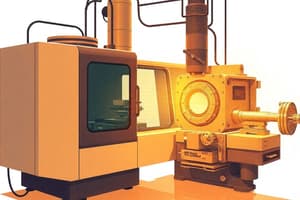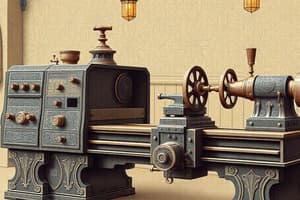Podcast
Questions and Answers
What is the primary function of a lathe?
What is the primary function of a lathe?
- To turn an object around a central axis (correct)
- To drill holes in wood and metal
- To cut sheets of material into smaller pieces
- To polish surfaces using a chemical solution
Which component of the lathe is responsible for holding the material steady during operation?
Which component of the lathe is responsible for holding the material steady during operation?
- The spindle
- The tail stock (correct)
- The chuck (correct)
- The carriage
How has the introduction of CNC technology impacted lathe operations?
How has the introduction of CNC technology impacted lathe operations?
- It allows for faster and easier execution of tasks. (correct)
- It has reduced the types of operations a lathe can perform.
- It has made it more challenging to operate lathes.
- It has eliminated the need for skilled craftsmen.
What does the term 'CNC' stand for in the context of lathes?
What does the term 'CNC' stand for in the context of lathes?
What is the role of the spindle in a lathe?
What is the role of the spindle in a lathe?
Describe how the transition from mechanical lathes to CNC lathes has affected the precision of manufacturing.
Describe how the transition from mechanical lathes to CNC lathes has affected the precision of manufacturing.
What are some advantages of using a CNC lathe over a traditional mechanical lathe?
What are some advantages of using a CNC lathe over a traditional mechanical lathe?
In the context of a lathe, explain the function of the chuck.
In the context of a lathe, explain the function of the chuck.
Discuss the roles of the headstock and tailstock in a lathe.
Discuss the roles of the headstock and tailstock in a lathe.
How do modern CNC lathes enhance the creation of custom pieces for crafts?
How do modern CNC lathes enhance the creation of custom pieces for crafts?
Flashcards are hidden until you start studying
Study Notes
Lathe Evolution
- Lathes are machines used to rotate objects around a central axis.
- Originally, lathes were simple tools that were operated manually by craftsmen.
- They were used to shape wood, metal, and other materials.
- Modern lathes are more advanced, known as CNC lathes.
- CNC lathes use computer programs for operations.
- CNC technology enables faster and more precise turning of different materials.
- The CNC lathe is a revolution in manufacturing, allowing for the creation of complex shapes efficiently.
Key Parts of a Lathe
- The headstock holds the material in place and houses the spindle.
- The spindle rotates the material using power provided by an engine.
- The tailstock supports the other end of the workpiece.
- The carriage holds cutting tools for shaping the material.
- The chuck firmly grips the material during the turning process, maintaining stability.
Lathe Development
- Lathes have evolved from simple hand-operated tools to advanced computer-controlled machines.
- Historically, lathes were used to shape materials like wood and metal using manual commands.
- Modern CNC lathes utilize computer programs for more efficient and accurate operations.
- The CNC in CNC lathe stands for Computer Numerical Control.
Lathe Components & Function
- The lathe's headstock and tailstock secure the material being worked on.
- The spindle rotates the material, powered by an engine.
- The carriage holds the cutting tools.
- The chuck grips the material firmly to prevent movement during operation.
- Lathes create parts for machines, tapped sheets, and custom crafts.
Modern Lathe Advantages
- Modern lathes achieve precise and rapid creation of complex shapes.
Studying That Suits You
Use AI to generate personalized quizzes and flashcards to suit your learning preferences.




